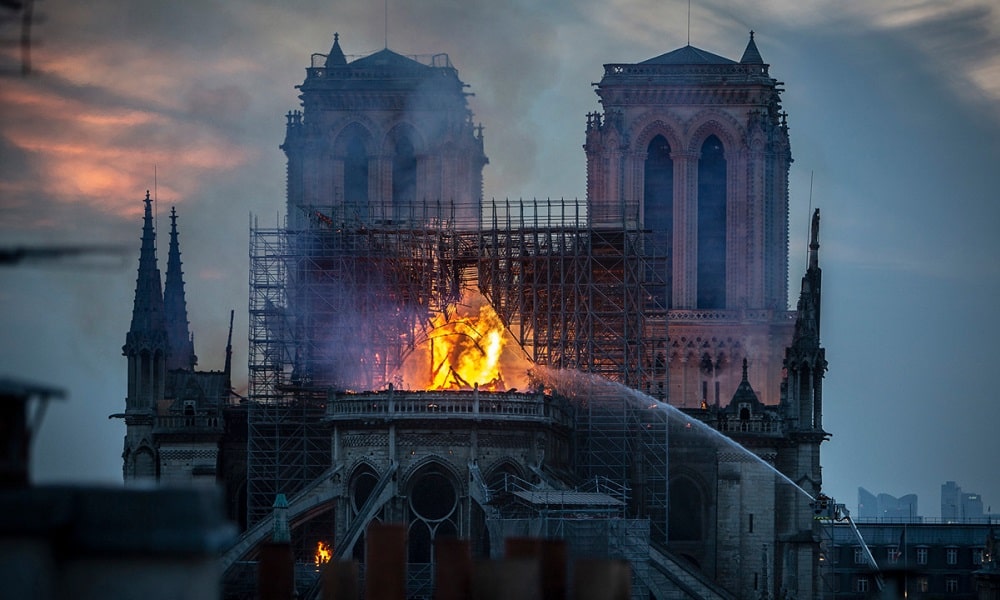How can 3D save Notre-Dame?
Posted By Lucie Gaget on May 7, 2019 | 0 comments
Additive manufacturing technology can be used in many cultural aspects. For example, we already saw the benefits of this cutting-edge technology for museum conservation. Plus, if 3D printing can be a great advantage for architecture, it can also be a perfect solution for architectural restoration.
Let’s see how 3D scanning and 3D printing can actually be used after the catastrophe of Notre-Dame. How this great monument could benefit from technologies such as 3D printing? Let’s discover how 3D printing and 3D scanning can save Notre-Dame.
Benefits of 3D scanning for conservation
Scanning for museum conservation
3D scanning is a way to save data. Indeed, some monuments, artifacts, or really fragile objects can be saved with this 3D technology. Their image can be saved in three dimensions.
All the data collected can be used to create digital museums or archives, but also to visualize the artefacts, or to 3D print perfect replicas. Moreover, it is an opportunity for researchers to analyze them if they are too fragile to be manipulated. 3D scanning allows for getting real and accurate information about an object, a monument, or even a person.
3D scans of Notre-Dame
In Paris, on the 15th of April, a fire partially destroyed Notre-Dame, a 850 years old monument. This is naturally a huge loss because such an architectural piece can’t be brought back identically today, with the same processes and materials.
However, due to this catastrophe, an important reconstruction work needs to be done. This process will take several years, but how could technology help during this process? In the case of Notre-Dame, a full and precise 3D scan of the monument already exists, since 2015. This precious 3D will help to reconstruct the cathedral.
Check out the video below to see the work that has been made to get laser scans of the cathedral:
It is also a way to preserve archives of important parts of our history and make them last in time. As we recently saw with the fire in Notre-Dame, these monuments could disappear in a few minutes.
How could 3D printing be used for reconstruction
Rethink our relationship with art and culture
But 3D scanning is not the only efficient technique to save data about fragile artifacts, or any precious objects we can find in a museum. Indeed, 3D printing can be used for the reproduction of ancient objects and art pieces, and it could be way more useful than you would think. Let us explain it to you.
Additive manufacturing can be used to recreate really detailed objects, which could be presented to the public in museums. This way, the real object could be preserved for the public and would not be directly in contact with the museum visitors. This solution can be used for really fragile objects. Indeed, as we all know, some visitors are sometimes tempted to touch objects in a museum, but with 3D printed replicas, there is no need to put these « Do not touch » signs everywhere, and they could actually be as curious as they want, taking the objects in their hands. We can see it as a new way to develop engagement and interaction, to rethink the whole museum experience thanks to new technologies.
Can we 3D print Notre Dame?
In the case of Notre-Dame, a huge architectural monument, could 3D printing be used? No, for the moment, giant concrete 3D printers won’t be sent in Paris to 3D print the missing parts of Notre-Dame. But, additive manufacturing could actually be used on many other different aspects.
For example, by using the 3D scans that we already have, it could be possible to print a very detailed mock-up, that could help during the reconstruction process. For Notre-Dame, some changes could be added in the 3D scan and then printed to help to visualize the work and test new modifications that need to be done. 3D printing is also a great tool for demonstration. Indeed, 3D printed mock-ups can show everyone the final results. Additive manufacturing is already well used in the architecture sector, as we already saw at Sculpteo with Valoptim.
Additive manufacturing is also allowing to print bigger parts, that could be used in the actual monument, such as replacement parts. Molds could also be 3D printed for decorative parts inside the cathedral before their reconstruction.
Clément Moreau, CEO, and co-founder of Sculpteo explains on the TV channel BFM Business that for these kinds of projects “3D printing allows to combine handcraft and technology, we can produce mock-ups, we can produce molds, we can produce temporary structures, with digital technologies, all of this is actually serving handcraft, to create amazing projects.”
To see the whole interview, in French, click here!
What do you think about the use of 3D printing to help to reconstruct architectural monuments? If you have an architecture project, don’t hesitate to contact us, or, if you already have a 3D model, upload directly your 3D file on our online 3D printing service and receive your 3D printed objects in a few days.
Subscribe to our newsletter for more information about the applications of 3D technologies.


 Connect with Google
Connect with Google Connect with Facebook
Connect with Facebook